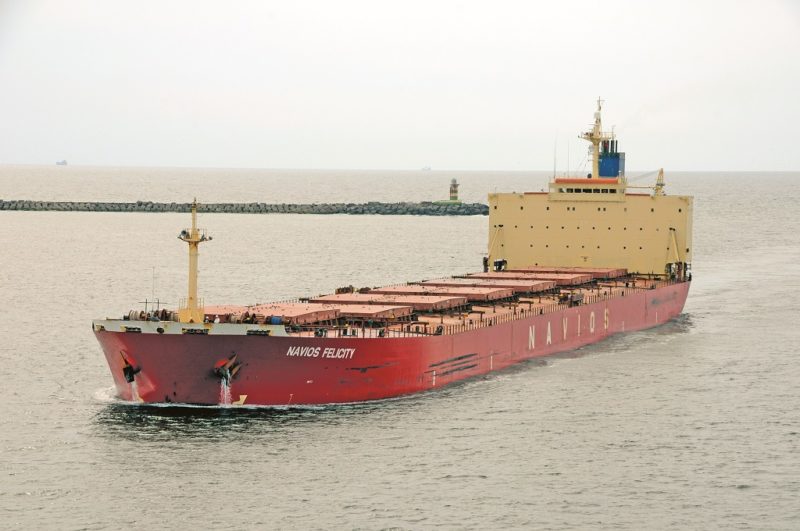
Ore, Dry Bulk and Tanker Fleets
Puerto Ordaz on the Orinoco river, of length 2,650 miles in Eastern Venezuela, is a major source of iron ore for the U.S. Steel mills along the Eastern Seaboard of the U.S.A. It is a modern, planned city which, together with the older settlement of San Felix, forms Ciudad Guyana in Bolivar State of Eastern Venezuela. It lies on a long torturous river channel with sand banks between 180 and 195 miles from the Orinoco Sea Buoy, thus far from the sea. It was founded on 9th February 1952 and lies at position 8°15′ North, 62°47′ West, with a current population of 70,600. The confluence of the Orinoco and Caroni rivers is nearby, and the industry of the area is completely involved with iron ore mines, iron and steel blast furnaces, hydroelectric power stations and aluminium plants using cheap electricity.
There are nine berths for deep sea bulk carriers at Puerto Ordaz as follows:
- Sidor Dock Mile marker 195
- River Side Mile marker 194
- Venalum Pier Mile marker 193
- Alcasa Floating Pier Mile marker 192
- Bauxilum Berth Mile marker 192
- Ferrominera Pier Mile marker 183
- Palua Berth Mile marker 182
- Edelca Pier Mile marker 182
- San Felix Pier Mile marker 180
Loaded vessels are occasionally aground in the dry season, either temporarily or for some time, with Navios Trader grounded on 26th October 1994 on a sandy bottom in the Orinoco between Mile marker 104.1 and Mile marker 104.9. Tugs could not refloat her that day, and the vessel was part lightened of iron ore and refloated on 4th November, and anchored near the Orinoco Sea Buoy on 8th November 1994.
Iron ore was first discovered in Cerro Bolivar in 1947, a remote part of North Eastern Venezuela, and two years later U.S. Steel formed the Orinoco Mining Company in Delaware to exploit the area with mines, allocating $200 million for the cost of digging and opening the mines and very extensive dredging of the relatively shallow, twisting bends of the Orinoco river. The first iron ore was exported to the U.S.A. in 1953 by two independent shipping companies, firstly National Bulk Carriers of the Universe Tankships Inc. owned by Daniel K. Ludwig, and secondly bulk carriers of Transworld Carriers Inc. of the Joshua Hendy Corporation, first set up in 1861. U.S. Steel then incorporated in December 1953, Navios Inc. registered in Monrovia in Liberia with another office in Nassau in the Bahamas, with an investment of $50,000 by U.S. Steel in Navios Inc.
This company did not own any ore carriers, but chartered from the two charterers from July, 1954.
Radio officers of these ore carriers had much radio traffic when navigating the river, as they communicated hourly with Puerto Ordaz radio station to give their upriver or downriver position and to receive river information as to the height of the water depths and the amount of shipping traffic in the narrow channel leading from the sea. Navios Inc. had around 60 to 80 employees between 1954 and 1960, with U.S. Steel paying Navios Inc. for the cost of exporting the iron ore to the U.S.A.
The Navios Inc. charters were almost always time charters at around 90% of the total, with voyage charters for the remaining 10%.
Navios Inc. also transported iron ore to other U.S. domestic steel companies, and also to British steel companies, discharging at Newport, Tyne and the General Terminus at Glasgow. The freight rate was taken from Swedish iron ore prices as the going rate even though the distance travelled was 50% more than to the U.S.A.
During the four years from 1957 to 1960, Navios Inc. earned $391 million in gross revenue, with the majority of the iron ore going the U.S. Steel plants (73%), 22% to foreign steel plants, and 5% to other independent steel producers in the U.S.A. These enormous transportation costs were considered very excessive by the U.S. Tax Court, which estimated that Navios Inc. had overcharged by 25%, and ordered repayments and reallocation of assets. These amounted to $11.1 million in 1957, $10.27 million in 1958, $9.88 million in 1959, and $16.815 million in 1960, just to U.S. Steel alone. In the seven years from 1954 to 1961, Navios Inc. had accumulated almost $80 million in cash but had not paid any dividends to U.S. Steel.
The U.S. Tax Court ordered the allocation of $52 million of the income of Navios Inc. to U.S. Steel for those seven years. The vast quantities of iron ore exported and the transportation costs from the Orinoco during the four years from 1957 to 1960 is now given:-
1957 U.S. Steel 7.223 million tonnes $65.274 million
Shenango Steel 0.150 million tonnes $1.403 million
Pittsburgh Steel 0.157 million tonnes $1.422 million
Sharon Steel 0.268 million tonnes $2.587 million
Youngstown Sheet Tube 0.0837 million tonnes $0.814 million
Jones Laughlin 0.0555 million tonnes $0.497 million
1958 U.S. Steel 8.116 million tonnes $76.043 million
Shenango Steel 0.247 million tonnes $2.483 million
Pittsburgh Steel 0.0544 million tonnes $0.528 million
Sharon Steel 0.1147 million tonnes $1.173 million
Youngstown Sheet Tube 0.7510 million tonnes $0.767 million
Jones Laughlin 0.121 million tonnes $1.180 million
1959 U.S. Steel 8.717 million tonnes $80.278 million
Shenango Steel 0.2998 million tonnes $2.976 million
Pittsburgh Steel 0.1543 million tonnes $1.479 million
Sharon Steel 0.215 million tonnes $2.141 million
Youngstown Sheet Tube 0.0796 million tonnes $0.411 million
1960 U.S. Steel 8.171 million tonnes $78.178 million
Shenango Steel 0.0664 million tonnes $0.411 million
Pittsburgh Steel 0.044 million tonnes $0.147 million
Sharon Steel 0.164 million tonnes $0.823 million
Youngstown Sheet Tube 0.124 million tonnes $0.311 million
The mined iron ore of the Orinoco Mining Corporation was subject to a maximum Venezuela tax of 50% on net income, as well as the Orinoco Mining Corporation also being subject to U.S. income tax, but the U.S. foreign tax credit offset this amount.
Navios Inc. was subject to a 2.5% Venezuelan excise tax and was exempt from U.S. income tax. The Puerto Ordaz regional production of iron ore took a huge drop in 2017, after the mine caught fire in June 2017, with production halted for six months, normal present production is 4.5 million tonnes per year.
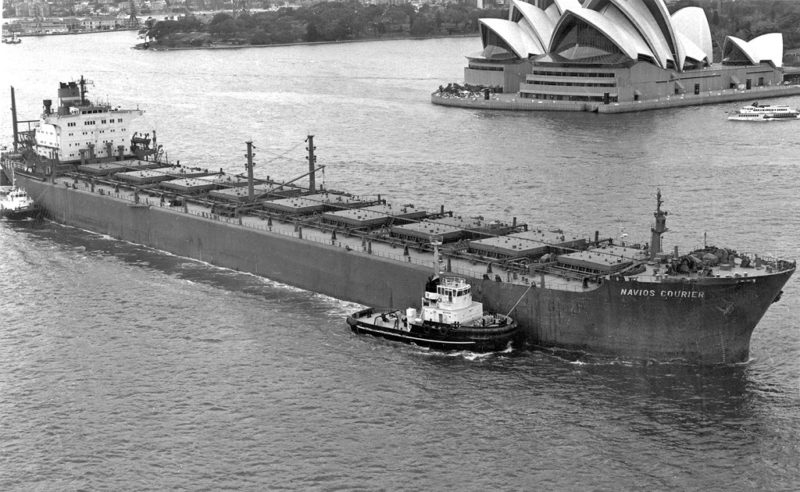
ORINOCO ORE CARRIER FLEETS
Shipments of iron ore from Puerto Ordaz for US. Steel and other domestic U.S. steel producers were sent to Baltimore (Maryland), Pittsburgh (Penn), Morrisville (Penn) and Philadelphia (Penn) and other iron and steel plants.
National Bulk Carriers Inc. of the Universe Tankships Inc. ordered fourteen big ore carriers in four sizes for delivery between 1954 and 1961 from Japanese shipyards. All of this fleet had bridge ‘midships, engines aft with four holds and twelve hatches to distribute the iron ore evenly for stability. This fleet had black hulls and black funnels and was as follows:-
Year Grt Dwt Dimensions (Feet)
- Ore Monarch 1956 15,665 44,652 736 x 98 x 37
- Ore Prince 1956 15,665 44,652 736 x 98 x 37
- Ore Regent 1956 15,665 44,652 736 x 98 x 37
- Ore Convey 1956 16,015 30,645 655 x 90 x 33
- Ore Titan 1954 20,910 59,814 784 x 115 x 40
- Ore Transport 1955 20,910 59,814 784 x 115 x 40
- Ore Chief 1954 20,910 59,814 784 x 115 x 40
- Ore Jupiter 1959 18,122 51,430 751 x 102 x 33
- Ore Mercury 1959 18,122 51,474 751 x 102 x 33
- Ore Meteor 1959 18,122 51,335 751 x 102 x 33
- Ore Meridian 1959 18,122 51,342 751 x 102 x 33
- Ore Neptune 1959 18,249 50,987 751 x 102 x 33
- Ore Saturn 1960 18,249 50,621 751 x 102 x 33
- Ore Venus 1961 16,630 51,145 751 x 102 x 33
The seven units of the Ore Jupiter class had reduced depth and loaded draft, as experience with the Ore Chief class had shown that it was difficult to navigate the Orinoco river with very large, deep draft ships, even with twin screws and the best of navigation. Daniel K. Ludwig had to resort to sending the Ore Chief class part loaded down the Orinoco river to the Orinoco Sea Buoy, where the stationary transhipment vessel, Ore Convey, topped them up to their full deadweight for the voyage north. He also built the large river dredgers Zulia and Icoa to keep the navigation channels open. All of these ore carriers were powered by steam turbines manufactured by General Electric, or Westinghouse Electric, and served until the late 1970s when they were broken up or converted into transhipment vessels.
The quintet of ore carriers of Transworld Carriers Inc., a subsidiary of Joshua Hendy Corporation, founded in 1861, were Rio Caroni, Rio Macareo, Rio Barima, Rio Manamo and Rio Orinoco of 12,860 grt and 37,200 dwt and were built by the Deutsche Werft yard in Hamburg between 1957 and 1959. They had bridge ‘midships, engines aft with an overall length of 650 feet, moulded beam of 86.2 feet, and a loaded draft of 36.3 feet, and were powered by steam turbines manufacture by Allgemeine Electric Company of Berlin. This quintet had grey hulls and Navios Inc. funnel colours, and served the Orinoco ore trade until they were broken up between 1975 and 1979.
Navios Inc. was largely responsible for opening up the Orinoco river to navigation by large, ocean going ore carriers, and also for establishing offshore transhipment operations at the mouth of the river. It also played a critical role in opening the Gulf of St. Lawrence to winter navigation from the big iron ore export port of Sept Iles. Navios Inc. also pioneered both lead and zinc transhipment operations off the coast of Alaska and north of the Arctic Circle.
Navios Inc. chartered bulk carriers for cargoes other than iron ore for operation worldwide from the Valles Steamship Co. Ltd. of Hong Kong, the Ugland Brothers bulk fleet of Norway, the Nissui and Nisshin Shipping Corporations of Tokyo, the Seafarers Shipping Company of Manila, the Oak Steamship Co. Ltd., and Unique Shipping Agencies, both of Hong Kong, Mitsubishi Ore Transportation of Japan, Philippines Pacific Ocean Lines Inc. and Seahorse Marine Corporation, both of Manila, Nafsiploia Maritime Corporation of Piraeus, Rubicon Shipping Corporation S.A. of Panama, and many other shipping companies.
Navios Inc. has diversified over the decades in the scope of its worldwide activities, with a total of 50 bulk carriers owned between 1975 and 2005, 50 owned and chartered bulk carriers in 2010, 92 owned and chartered bulk carriers and 40 owned and chartered tankers in 2016, and today in 2022 it has a large fleet of 36 owned Handysize, Handymax, Panamax, Kamsarmax, Post Panamax and Capesize vessels, as well as a similar number of chartered and owned tankers of a total of 7.4 million deadweight.
The current Navios Inc. fleet have red hulls with ‘NAVIOS’ in large bold white capitals on both sides, with blue funnels with a white ‘N’ on a red circle over two narrow white bands. The Navios Inc. logo and houseflag consists of three blue horizontal bars with a central large blue ‘N’ for Navios forming a circular centrepiece. The Navios Inc. fleet transport raw materials worldwide including iron ore, agricultural products with many forms of grain including soya, wheat and barley, industrial cargoes of coal, petroleum coke, and bauxite, as well as sugar and many other bulk cargoes.
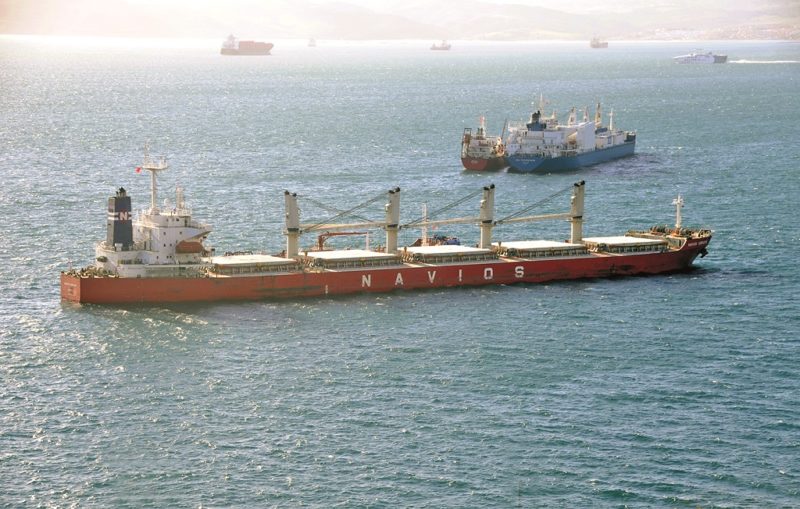
NAVIOS MARITIME HOLDINGS INC.
This publicly quoted company was founded on Grand Cayman in the Caribbean in 1992 by a group of Greek shipbrokers and charterers including Spyridon Magoulas and John Stratakis, with a Head Office in George Town, Cayman Islands, and other offices in Piraeus and New York. Ms. Vasiliki Papaefthymiou was Executive Vice President Legal, and Anna Kalathakis as Secretary, both serving from the inception of the company. Dry bulk carriers were owned until tankers began to be owned in 2010 managed by Navios Tankers Management Inc.
Elias Frangos, a third generation Greek shipowner, and Stavros Livanos, father of Athina (Tina) Livanos, were partners in several Greek shipping companies in the late 1940s and early 1950s. Capt. Nicolas Frangos, son of Elias, also managed Greek ships, while the granddaughter of Elias, Angeliki Frangou, born on the island of Chios in 1965 was destined to become a fifth generation shipowner. Many Greek shipowners live on the island of Chios, famous for its windmills and gum mastic, with a nickname of ‘The Mastic Island’.
Angeliki Frangou crossed the Atlantic in 1990 at the age of 25 years on one of her father’s ships to study Mechanical Engineering at Farleigh Dickinson University in New Jersey, and also began an MBA course at New York University, but never graduated as she took a job as an analyst on the trading floor of the Republic National Bank, working there for two years. She learnt all about credit default insurance and to judge whether to take financial risks, together with the marine charter world of charter parties for the transport of hundreds of cargoes e.g. soya beans, wheat, ores, coal and grain.
In April 1990, Angeliki Frangou was busy looking over a laid-up run-down SD14 cargo ship in Rio de Janeiro, and delving deep into her engine room and propeller shaft to see whether she could be easily brought back into service. Fulvia of 14,500 dwt had been built at Niteroi near Rio de Janeiro as L/L Peru, built in 1973 for Lloyd-Libra S. A. of Brazil. The SD14 took four months of repairs and $1.5 million of her father’s funds to ready her for her first voyage to ports in the U.S.A. The freight rates for this voyage far exceeded her expectations. Fulvia continued to make good profits, and maintenance was kept to an absolute minimum, with repairs done afloat and not at expensive shipyards.

Angeliki Frangou returned to Brazil to buy ships at auction at knock down prices, including Lloyd Alegrete of 14,650 dwt and built at Niteroi as a larger Prinasa 121 class of Brazilian standard ship from the Brazilian CCN Maua yard at Niteroi in Rio de Janeiro, but based on the SD15 standard design of Austin & Pickersgill Ltd. with six electric deck cranes. She was built for Cia de Navegacao Lloyd Brasileiro in 1981, but needed a new bow fitted after severe collision damage in 1986. She was renamed Challenger IV in a fleet of a dozen owned ships by Millennium year. Bulkers included the former seven hold seven hatch Graig Shipping of Cardiff bulker Graigwerdd of 38,095 dwt built in 1982, the five hold five hatch bulker Korean Pioneer of 36,757 dwt and built in 1983 for South Korean owners. The five hold five hatch bulker World Quince of 41,516 dwt was purchased from the World-Wide Shipping Group and renamed Ulysses II. A quartet of bulkers of 20,300 dwt was purchased as Astra Peak, Apollo Peak, Gloria Peak and Primera Peak from Japanese owners and renamed with Greek names.
In 2004, Angeliki Frangou used a specially set up shipping company with no income or revenue to buy the International Shipping Enterprises, which U.S. Steel had set up in 1954 to export iron ore from Venezuela and Canada to the U.S.A. Navios was then floated in 2004 on the New York Stock Exchange (NYSE), with many investors in the company to make it an important and public entity shipping company in 2005, quite different from most Greek owned shipping companies, which are private entities. She quickly followed up this purchase by setting up four new public companies floated on the NYSE by 2017:-
- Navios Maritime Partners Inc., which offered high dividend yields to investors.
- Navios Maritime Acquisitions Inc. to run the big tanker fleet.
- Navios South American Logistics Inc. to run a barge and port business in Uruguay and Paraguay with a river port in the latter country, and created by the acquisition of Horamar S.A., operators of a bulk terminal in Uruguay.
- Navios Europe Inc. owned 47.5% by Navios Maritime Holdings Inc., 47.5% by Navios Maritime Acquisitions Inc., and 5% by Navios Maritime Partners Inc., operating twenty containerships of up to 6,763 TEU capacity on charter to ANL of Australia, CMA CGM of France, MSC of Italy and Switzerland, and Yang Ming of South Korea, and other worldwide container lines.
- Logistics income also came from, for example, long term port contracts of twenty years duration with Vale S. A. of Brazil, as well as other port operation contracts, however the container ships were sold off and Navios Europe Inc. was liquidated in February 2020.
Navios South American Logistics Inc. owns a fleet of 30 pusher tugs, 268 dry barges, 58 tank barges, three LPG barges, and eight double hulled product tankers of up to 17,500 dwt named Estefania H, Malva H, Makenita H, Sara H, San San H, Ferni H, He Man H, and Elena H, in addition to port facilities in Uruguay and Paraguay.
The Navios Inc. Board of Directors in 2021 has Angeliki Frangou as Chief Executive Officer and Chairwoman with 29.5% holding in Navios, and directors Efstathios Loizos, Spyridon Magoulas, George Malanga, Vasiliki Papaefthymiou, John Stratakis, Shunji Sasada and Michael Pearson. George Achinotis is the Chief Financial Officer. The revenue and turnover of the Navios Inc. Group financial results for the years 2016, 2017, 2018, 2019, 2020 and 2021 in outline is as follows:-
2016 Dry Bulks + Logistics $419.8 million
2017 Dry Bulks + Logistics $463.0 million
2018 Dry Bulks + Logistics $479.1 million
2019 Dry Bulks + Logistics $482.4 million
2020 Dry Bulks $200.8 million or 48.2% of total of $467.1 million
Logistics $215.9 million or 51.8% of total of $467.1 million
2021 Dry Bulks $362.34 million or 61.9% of total of $585.82 million
Logistics $223.48 million or 38.1% of total of $585.82 million
Since 2009, Navios Inc. has raised over $3 billion in equity to expand the bulk fleet by securing long term contracts, providing cash flow stability, and reducing maintenance costs by making repairs at sea instead of at expensive repair yards. Navios Maritime Holdings Inc. secured a loan facility of $115 million in June, 2021.
All Greek shipping companies have an advantage over other worldwide operators in that they do not pay income tax, although a small levy on the vessel deadweight tonnage has recently been introduced. This is what makes Greek shipping so competitive in a very international business, with the majority of Greek shipowners saying they would rather go out of business if they had to pay income tax.
The Navios Inc. Head Office in Piraeus is a large, seven storey glass structure with a very modern Reception on the ground floor. All around are models of ships in glass cases from various eras, together with small axes in glass boxes, which were used to christen each Navios Inc. new ship by cutting the ribbon fastened to the champagne bottle that was smashed against the bow of the hull.
Navios Inc. also has offices in New York, Antwerp, Buenos Aires, Montevideo and Asuncion in Paraguay. The ticker symbols of Navios Inc. companies on the New York Stock Exchange are ‘NM’, ‘NNA’ and ‘NMM’.
The Navios Inc. fleet are currently fixed on one year charters at between $14,000 per day up to $30,000 per day. In 2008, before the worldwide financial crash, freight rates were much better, with Navios Inc. securing long term charters for four Capesize vessels with one for ten years at $41,325 per day, another for five years at $57,000 per day, another for 3.5 years at $49,400 per day, and the fourth and last for three years at $38,000 per day.
Navios Sagittarius was aground off the coast at Laeso in Denmark on 22nd July 2011 while on a voyage to Skagen to load bunkers prior to starting a long worldwide voyage to Singapore.
She was refloated a few days later and dry-docked for inspection.
Navios Amaryllis was aground on the Rasfaree Reef at Kaafu Atoll in the Maldives on 19th August 2021 while on a voyage in ballast from India to South Africa. She had experienced engine failure and drifted onto the reef, causing much damage to the precious coral. The Maldives Government fined Navios Inc. $10 million after holding the vessel in custody until December 2021, the payment was made to release the vessel from custody.
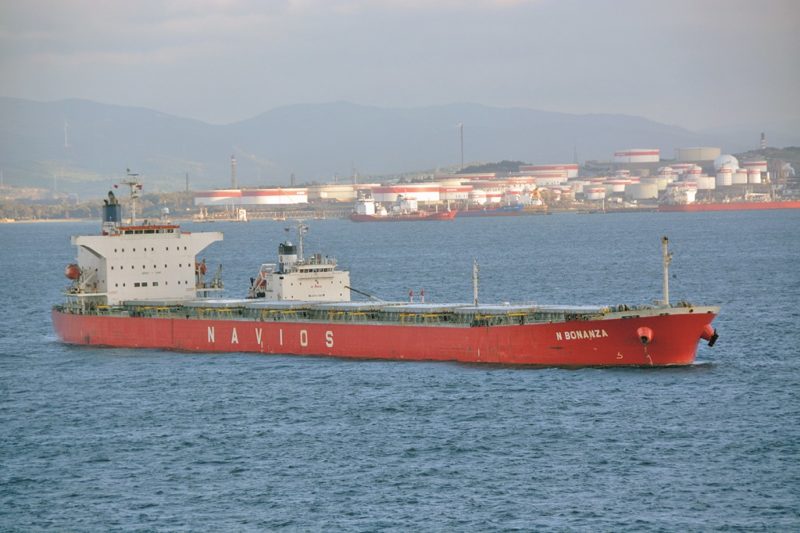
NAVIOS INC. NOMENCLATURE and VOYAGES
In 1975, Navios Inc. began a standard ship nomenclature of a prefix ‘Navios’ followed by another word from the theme of the classes of all of their many owned and chartered vessels.
The names of the fleet of bulk carriers and tankers are now given in their respective size categories since 1975 up to 2021.
BULK CARRIERS
OBO (OIL, BULK, ORE)
Navios Challenger, Navios Crusader, Navios Champion, Navios Collier, Navios Commander, Navios Commodore and Navios Courier.
HANDYSIZE and HANDYMAX up to 65,000 DWT
Navios Mariner, Navios Merchant, Navios Miner, Navios Monarch, Navios Trader, Navios Valor, Navios Voyager, Navios Pioneer, Navios Mercator, Navios Meridian, Navios Arc, Navios Horizon, Navios Vector, Navios Herakles, Navios Hios, Navios Kypros, Navios Ionian, Navios Apollon, Navios Achilles, Navios Vector, Navios Serenity, Navios Sagittarius, Navios Armonia, Navios Primavera, Navios Celestial, Navios Centaurus, Navios Astra, Navios La Paix, Navios Lyra, Navios Oriana, Navios Serenity, Navios Soleil, Navios Vega and Navios Venus.
PANAMAX 65,000 DWT to 80,000 DWT
Navios Bulker, Navios Enterprise, Navios Dynasty, Navios Mariner, Navios Minerva, Navios Magellan, Navios Galaxy, Navios Star, Navios Cielo, Navios Alegria, Navios Aurora, Navios Hope, Navios Ulysses, Navios Esperanza, Navios Orion, Navios Asteriks, Navios Orbiter, Navios Libra II, Navios Hyperion, Navios Felicity, Navios Gemini S, Navios Aldebaran, Navios Amitie, Navios Galileo, Navios Helios, Navios Horizon, Navios Northern Star, Navios Sun, Navios Taurus, Navios Bonanza, Navios Rainbow and Navios Amalthia.
AMSARMAX 80,000 DWT to 90,000 DWT
Navios Patriot, Navios Pioneer, Navios Titan, Navios Prosperity, Navios Altair, Navios Amber, Navios Avior, Navios Harmony, Navios Marco Polo, Navios Southern Star, Navios Sky, Navios Sphera, Navios Citrine, Navios Dolphin, Navios Gemini, Navios Herakles, Navios Uranus, Navios Felicity, Navios Magellan II and Navios Galaxy II.
POST-PANAMAX 90,000 DWT to 160,000 DWT
Navios Courier, Navios Protector, Navios Unique, and Navios Jupiter.
CAPESIZE 160,000 DWT to 180,000 DWT
Navios Fantastiks, Navios Aurora II, Navios Fulvia, Navios Etoile, Navios Altamira, Navios Happiness, Navios Buena Ventura, Navios Luz, Navios Lumen, Navios Bonavis, Navios Phoenix, Navios Stellar, Navios Pollux, Navios Antares, Navios Melodia, Navios Azimuth, Navios Bonheur, Navios Gem, Navios Joy, Navios Koyo, Navios Mars, Navios Obeliks, Navios Ray, Navios Felix, Navios Canary, Navios Corali, Navios Beaufiks, Dream Canary, Dream Coral and King Ore.

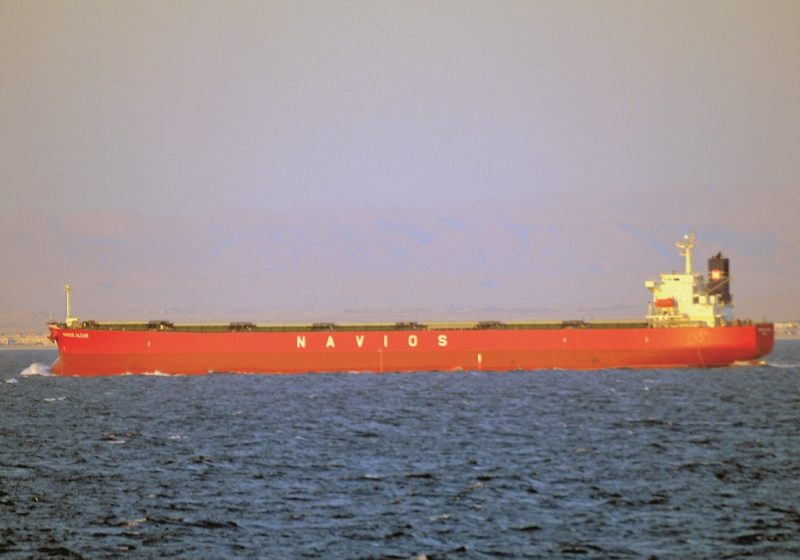
TANKERS
HANDYSIZE 25,000 DWT to 45,000 DWT
Nave Cosmos and Nave Polaris.
AFRAMAX 45,000 DWT to 120,000 DWT
Nave Alderamin, Nave Andromeda, Navios Aquila, Nave Ariadne, Nave Atria, Nave Atropos, Nave Bellatrix, Nave Dorado, Nave Equator, Nave Equinox, Nave Estrella, Nave Jupiter, Nave Orbit, Nave Orion, Nave Pulsar, Nave Pyxis, Nave Rigel, Nave Sextans, Nave Titan, Nave Universe and Nave Velocity.
VLCC 160,000 DWT to 300,000 DWT
Nave Buena Suerte, Nave Electron, Nave Galactic, Nave Neutrino, Nave Photon, Nave Quasar, Nave Spherical and Nave Synergy.
The word ‘Navios’ was shortened to ‘N’ in some names of company ships, either as a prefix or suffix, in recent years, and the owned and long term chartered in the Navios fleet of bulk carriers and tankers were on the following long voyages in May 2022:-
BULK CARRIERS
- Navios Ulysses – Mina Saqr (United Arab Emirates) to Singapore
- Navios Celestial – Sakaide the Panama Canal
- Navios Vega – Algeciras to Abidjan
- Navios Taurus – Paradip Garh (India) to Paranagua (Brazil)
- Navios Asterisks – Tianjinto Kalama (USA)
- N Amalthia – Le Havre to Kamsar (Guinea)
- N Bonanza – Hamburg to Destrehan, Louisiana
- Rainbow N – Richards Bay to Ploce with coal
- Jupiter N – Gladstone to Richards Bay to load coal
- Navios Galileo – Port Edward (Canada) to Chiwan (China)
- Navios Stellar – Port Cartier (Canada) to Port Said and Suez
- Navios Happiness – Port Hedland to Dangjin (South Korea) with iron ore
- Navios Phoenix – Lazaro Cardenas (Mexico) to San Nicolas (Peru)
- Navios Lumen – Shanghai to Newcastle (NSW) to load coal
- Navios Antares – Sokhna (Egypt) to Gibraltar
- Navios Etoile – Port Cartier (Canada) to Cagliari
- Navios Bonheur – Qingdao to Hay Point (Australia) to load coal
- Navios Altamira – Dalian to Caldera (Chile)
- Navios Canary – Saldanha Bay (South Africa) to Dampier
- Navios Corali – Jiangyin to Teluk Rubiah (Malaysia)
- Navios Lyra – Bontang (Indonesia) to Lazaro Cardenas (Mexico)
- Navios Venus – Oran to Ghent
- Navios Amber – Taicang (China) to Lazaro Cardenas (Mexico)
- Navios Sky – Newcastle (NSW) to Onahama with coal
- Navios Coral – Bakar (Croatia) to Gibraltar
- Navios Citrine – Fangcheng (China) to Itaqui (Brazil)
- Navios Dolphin – Taicang (China) to Singapore
- Navios Gemini – Xiamen (China) to Vitoria (Brazil)
- Navios Horizon – Paradip Garh (India) to Santos
- Navios Felix – Cienaga (Colombia) to Panama Canal
- Navios Obeliks – El Dekheila to Nouadhibou (Mauritania)
- Navios Herakles – Gladstone to Singapore
- Navios Uranus – Paranagua to Singapore
- Navios Felicity – Paranagua to Port d’Andratx (Spain) with bunkers at Las Palmas
- Navios Galaxy II – Haldia (India) to Recalada (Argentina)
- Navios Magellan II – Baltimore and Norfolk to Marseille
TANKERS
- Nave Buena Suerte – Lagos Offshore Terminal (Nigeria) to Rotterdam
- Nave Spherical – Ras Tanura to Singapore
- Nave Galactic – Basrah Oil Terminal to Rotterdam
- Nave Photon – Ras Tanura to LOOP Offshore Oil Terminal, U.S. Gulf
- Nave Atropos – Singapore to Kertih (Malaysia)
- Nave Rigel – Ras Laffan (Qatar) to Yeosu (South Korea)
- Nave Estrella – Sohar (Oman) to Karachi anchorage
- Nave Cassiopeia – Arrived loaded at Jeddah anchorage
- Nave Cetus – At Tanjung Pelepas anchorage, Singapore
- Nave Andromeda – Le Havre to Antwerp
- Nave Cielo – Sika (India) to Daesan (South Korea)
- Nave Ariadne – Port Said to Haldia (India)
- Nave Velocity- San Francisco to Yokohama
- Nave Sextans – San Francisco to Ulsan
- Nave Pyxis – Al Fujayrah (UAE) to Sohar (Oman)
- Nave Luminosity – Baton Rouge to Houston
- Nave Jupiter – Itaqui (Brazil) to Rio de Janeiro
- Nave Alderamin – Yanbu (Saudi Arabia) to Jizan (Saudi Arabia)
- Nave Capella – Jeddah to Yanbu
- Nave Titan – Rabigh (Saudi Arabia) to Jeddah
- Nave Orion – Duba (Saudi Arabia) to Rabigh (Saudi Arabia)
- Nave Bellatrix – Mejillones (Chile) to Houston
- Nave Aquila – Tanjung Pelepas to Marsden Point
- Nave Atria – Amsterdam to New York
- Nave Cosmos – San Francisco to Stockton (USA)
- Nave Polaris – Singapore to Dumai (Indonesia)
- Hector N – Mossel Bay Terminal to Durban
- Perseus N – Rotterdam to Huelva
- Star N – Amsterdam to Las Palmas de Gran Canaria for bunkers and on to Conakry for discharge
- Lumen N – Limetree Bay (U.S. Virgin Islands) to Balboa
- Aurora N – Long Beach and Los Angeles to Balboa
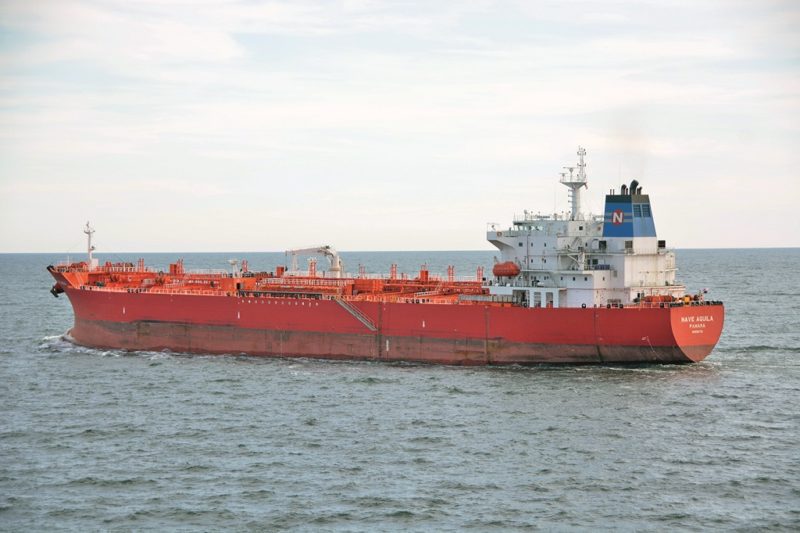
SUMMARY
It is very pleasing to note that the present Navios Inc. fleet is carrying iron ore from Port Hedland in Western Australia to ports in Japan, China and India. This was the original trade of Navios Inc. from Puerto Ordaz on the Orinoco River in Venezuela in 1954 to U.S. Eastern Seaboard ports for U.S. Steel. Navios Inc. was a Liberian company registered in Monrovia originally, but was managed for the next forty years by U.S. managers in Connecticut, at Stamford (CT) and later at Greenwich (CT).
Navios Corporation Inc. was registered as a stock type company on 5th September 1989, with a Head Office in Stamford Harbour Park in Stamford (CT), with Sean Day as President, Paul L. Hedger as Vice President (Operations), Bruce C. Hoag as Vice President (Finance), and Anthony C. Whitworth as Vice President (Chartering). The subsidiary companies included Navios Handybulk Inc., Navios International Inc., Navios Pacific Inc., and Navios Ship Agencies Inc. Associated companies included Fednav Ltd. of Canada, Citicorp Finance of New York, and Wells Fargo Bank of San Francisco, with regional offices in Los Angeles, London and Montevideo.
Navios Corporation Inc. today has a Head Office in New York, and operates in the U.S. deep sea, coastal and Great Lakes transportation industry. Ted Petrone is President, Angeliki Frangou is Chairman, Bruce Hoag is Vice President (Finance), Vasiliki Papaefthymiou is Vice President (Legal), and Doris Tryfon is Vice President (Corporate Communications). Yearly sales are around $10 million with a parent company of the Navios Shipmanagement Inc. and seven other companies in this U.S. corporate family. Navios Corporation Inc. is part of Navios Maritime Holdings Inc. of the Navios Group with the big dry bulk and tanker fleets.
The setting up of Navios Maritime Holdings Inc. in Grand Cayman in the Caribbean in 1992 by Greek shipbrokers and charterers with a small number of chartered bulk carriers managed from Piraeus, did not expand into the big owned and long term chartered bulk carriers and tanker fleets of the Navios Inc. fleet of today until it was made into a public entity in 2004. Dry bulk carriers with ‘Navios’ as a prefix to their names, and tankers with ‘Nave’ as a prefix to their names created in recent years around 60% of the Navios Inc. total revenue, while logistics operations in Uruguay and Paraguay and port management contracts in these and other countries contribute around 40% of the total Navios Inc. revenue.
Periods of low water depths on the twisting and hazardous Orinoco river occur occasionally today, and still cause loaded bulk carriers to run aground on sand bars for several days and weeks until they are part lightened by the cranes of river craft into barges.

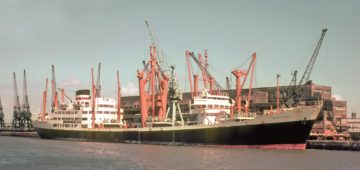


Comments
Sorry, comments are closed for this item